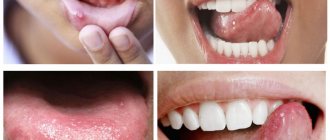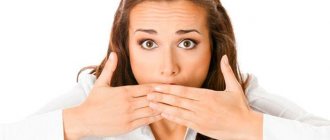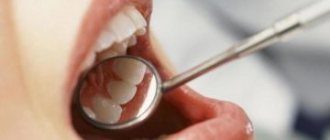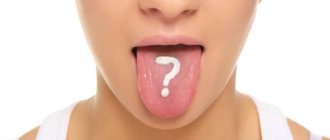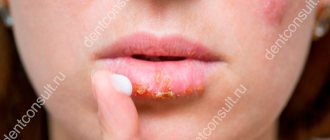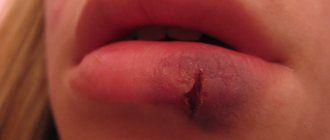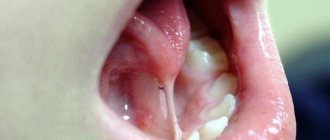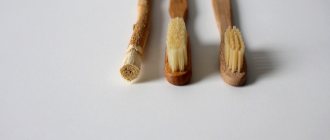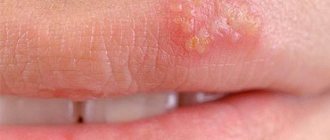Herpes
is a viral disease. One of the most well-known manifestations of a herpes infection is small, clear, painful blisters on the lips. Previously, in such a case they said “a cold on the lip popped up”, now they more often talk about “herpes on the lip”.
However, the family of herpes viruses is quite large. There are several types of herpes virus that can infect the human body. The most studied types are:
- herpes simplex virus type 1
(HSV-1). It is he who is responsible for pimples on the lip. HSV-1 primarily affects the mucous membranes of the lips, oral cavity and nasopharynx. Herpetic rashes can also appear within the nasolabial triangle (in particular, on the wings of the nose), less often on the cheeks and other parts of the face. Recently, HSV-1 quite often becomes the cause of herpetic lesions of the genital area, where it is introduced through oral sex; - herpes simplex virus type 2 (HSV-2) – genital herpes
. Main manifestations: redness, the appearance in the area of redness of bubbles filled with liquid, tending to merge, the appearance of erosions and crusts at the site of the bubbles, itching, headache and muscle pain, increased urination; - chickenpox virus
(varicella) is a type 3 herpes virus. In people who have already had chickenpox, this type of virus causes herpes zoster. Therefore, this type of herpes is also called Varicella-Zoster; - Epstein-Barr virus
(Epstein-Barr viral infection - EBVI) is a type 4 herpes virus. It is the causative agent of mononucleosis, causes malignant diseases of lymphoid tissue, and is considered the cause of chronic fatigue syndrome; - cytomegalovirus
– herpes virus type 5. The virus poses a threat to children during fetal development. May affect internal organs.
How does the virus become infected?
The virus can be infected in different ways: airborne droplets, contact (through shared towels, cutlery, through kissing), sexual intercourse, self-expression (when the virus from ulcers enters healthy mucous membranes and infects them). You can become infected through a blood transfusion and a child can receive the virus from the mother in utero. The incubation period (from the moment of contact until the first signs appear) is 2-14 days. A person becomes contagious as soon as sores appear on the lip, and is contagious to others until the scabs fall off .
Photo: One of the most common ways of transmitting herpes is contact.
Possible consequences and complications
A watery pimple on the lip immediately after its appearance does not cause any abnormalities and is perceived as a harmless phenomenon. However, once enlarged, blister pimples cause a lot of discomfort. They itch and turn red.
If the rash is ignored, patients develop:
- expansion of the area of rashes;
- increased body temperature;
- the formation of a bloody wound on the lips;
- inflammation of the lymph nodes;
- damage to the mucous membranes of the mouth and pharynx;
- sepsis;
- speech impairment and difficulty eating.
A watery pimple on the lip grows within a few hours. With timely and proper treatment, the rash does not grow and goes away quickly. In some cases, to restore the surface of the lips, it is enough to eliminate the allergic trigger or use 1 drug that will quickly restore the patient’s health.
Why do cold sores appear on the lips?
Those who suffer from herpes have noticed that exacerbations begin along with ARVI. Herpes occurs when immunity decreases, the protective forces of which are used to suppress ARVI. Colds on the lips also appear when the body’s defenses are weakened: with chronic fatigue, lack of sleep, frequent stress, poor diet, alcohol abuse and active smoking, in women at the beginning of pregnancy and in the first 5-7 days after childbirth.
Photo: Colds on the lips can only appear if the immune system is weakened
Methods for diagnosing herpes
Diagnosis of herpes is carried out, first of all, on the basis of examination of the patient, since herpetic rashes have a certain specificity. However, your doctor may order laboratory tests. Laboratory tests can detect infection even in the absence of obvious manifestations.
Herpes test
Be prepared that if you suspect a herpes infection, the doctor will write a referral for a blood test, which will determine the presence of antibodies to the herpes virus in the blood. Based on the results of the analysis, it will be possible to judge not only the presence of the pathogen, but also its activity.
More information about the diagnostic method
Sign up for diagnostics To accurately diagnose the disease, make an appointment with specialists from the Family Doctor network.
How does herpes manifest?
In medicine, it is customary to distinguish 5 stages of the development of herpes simplex: 1. The first stage occurs when blisters appear. It manifests itself as burning and itching in the lip area, and its swelling. 2. The second stage begins with the appearance of bubbles. At first small, they grow and fill with clear liquid. After a couple of days the liquid becomes cloudy. 3. The third stage of the disease is characterized by rupture of the vesicles. In place of the burst blisters, ulcers with swelling form. This stage is dangerous due to the development of complications. The person at this moment is very contagious. 4. In the fourth stage, the ulcers become covered with a dense crust. 5. At the fifth stage, the crusts dry out and fall off. The symptoms go away. The person becomes no longer contagious.
How to deal with acne?
Treatment for acne depends on the severity of the disease. It is prescribed exclusively by a specialist. For mild to moderate acne, external therapy is primarily used18. For severe acne, emphasis is placed on systemic treatment18.
Clindovit® is a topical antibiotic that can be prescribed for acne vulgaris6. The main active ingredient in its composition is the antibiotic lincosamide clindamycin6. It fights a wide range of propionibacteria strains6. After contact with the skin, clindamycin quickly accumulates in comedones, exhibiting antimicrobial activity6. Clindovit® gel helps reduce free fatty acids on the skin6.
The drug must be applied twice a day (morning and evening) to previously cleansed and dry skin. The first results from treatment with a topical antibiotic usually become noticeable after 6-8 weeks. It is recommended to combine the use of the drug with the use of benzoyl peroxide or azelaic acid (Azelik® gel)18,28.
How can herpes be dangerous?
Herpes can cause many complications. Some of them are life-threatening.
- Bacterial complications. Most often, bacteria simply attach to the virus and the blisters fill with pus. If the blisters have already burst, then the ulcers become covered with pus, the pain in the lip becomes unbearable and a crust does not form.
- Herpetic stomatitis is a lesion of the oral mucosa. The disease begins with a sharp increase in temperature, salivation and sharp pain when chewing food. There are many blisters in the mouth, similar to herpes on the lips.
- Herpetic eye damage begins with pain in the eyes and lacrimation. A person cannot open his eyes due to severe pain. A dangerous condition that can result in blindness.
- Herpes of the esophagus. Occurs when herpes spreads from the lips. There are difficulties when swallowing, severe pain, refusal to eat and weight loss.
- Herpetic pneumonia and herpetic hepatitis occur in people with immunodeficiency and occur together with bacterial and fungal processes.
- Herpetic damage to the nervous system occurs in the form of meningoencephalitis and is the most severe form of herpes. It begins with a sharp headache, nausea and vomiting, high fever, movement disorders and convulsions. The disease is unfavorable.
Photo: To avoid complications, you need to start treating herpes in a timely manner.
Suspect No. 2 – acne
- Cause. Acne is a multifactorial disease. The main links in its pathogenesis are hyperkeratosis, excessive sebum production, colonization of propionibacteria, and inflammation. For example, if a small whitehead appears on the lip, a blockage of the sebaceous gland could occur, leading to the formation of a closed comedon.
- Emergence. Acne usually appears suddenly.
- Localization. With acne, pimples rarely appear on the lip, since there are few sebaceous glands in this area. Most of them are in the so-called seborrheic zone - the nose, forehead, chin, this is where acne occurs most often.
- Spring view. A slight swelling of red color; if a purulent pimple has formed on the lip, then a white head can be seen inside, the acne takes a cone-shaped shape.
- Quantity. Most often they pop out one at a time. In severe cases of acne, they may merge.
- Feel. Papules and pustules may be painful, especially when palpated.
After opening, the acne fades, so many people think that this is a great way to get rid of them, but this approach can lead to aggravation of the problem, an even greater spread of the rash.
What do pimples around the mouth mean?
The appearance of a rash on the face, especially around the mouth, requires special attention, because acne can be the first sign of serious health problems. If a pimple appears frequently above the lip, this may be a consequence of the following diseases and conditions:
- hormonal imbalance due to long-term use of contraceptives or age-related changes;
- problems in the functioning of the cardiovascular system;
- use of low-quality cosmetics;
- infectious dermatitis (rash caused by viruses, bacteria, fungi);
- perioral acne often results from chapping of the skin, prolonged exposure to ultraviolet rays, and the use of low-quality cosmetics;
- decreased immunity.
Very often, rashes mean that a functional disorder of the digestive system has occurred. First of all, this applies to the condition and functioning of the small intestine and duodenum. Pimples under the lower lip are a sign of a colon disorder.
Perioral dermatitis
The disease is also called steroid dermatitis, since pimples around the lips appear due to long-term use of topical medications that contain corticosteroids. Pimples usually appear only around the mouth; in rare cases, the cheeks, forehead and nose are affected. Treatment consists of discontinuing hormonal medications.
Acne
Frequent pimples in the mouth and chin area may be a sign of acne. This is a disease in which inflammation and blockage of the hair follicles and sebaceous glands occurs. Acne near the mouth can appear for a variety of reasons, causing cosmetic problems.
Groups of pimples on the upper lip may also indicate problems with the heart.
If a white pimple appears under the lower lip, it is strictly forbidden to squeeze it out. Acne requires immediate and proper treatment, otherwise there is a risk of worsening the problem. As a result, acne appears not only on the face, but also on other parts of the body.
Infectious processes
Pimples in the corners of the lips are a possible sign of infectious diseases. It is useless to squeeze out such pimples, as they will soon appear again. You need to consult a dermatologist or infectious disease specialist. After the infection is destroyed, the skin will gradually clear of rashes.
Infectious dermatitis can be provoked by staphylococci and streptococci, herpes, fungus (measles, scarlet fever, typhus, chickenpox, pyoderma). Acne caused by the subcutaneous demodex mite is not uncommon.
A white pimple under the lower lip is often a sign of furunculosis. It is strictly forbidden to squeeze out such rashes.
Rosacea
A red rash around the mouth is a symptom of the onset of rosacea. This is a chronic disease characterized by redness of the skin due to dilation of superficial capillaries on the face. Pimples near the lips and nose are accompanied by swelling and severe itching, and peeling begins. These moments negatively affect a person's life. The treatment is based on comprehensive facial skin care, diet and avoidance of harmful influences (frost, wind, heat).
Irritation
Severe irritation of the facial skin is the most common cause of acne on the upper lip. Various factors can provoke irritation:
- improper and inadequate nutrition, if the diet contains semi-finished products and fast food, increases the oiliness of the skin, and acne will not keep you waiting;
- touching your face with dirty hands;
- the use of cosmetics and essential oils that are not suitable for your skin type;
- prolonged exposure to wind and frost;
- stress and nervous tension.
Small red rashes around the mouth can be a reaction of the body to long-term use of certain medications.
Hormonal imbalances
Hormonal factors can cause a severe rash on the face in women. Pimples around the mouth often appear during pregnancy, after an abortion or miscarriage, and sometimes even before each menstruation. This is due to hormonal imbalance in the body. Such rashes will go away after it stabilizes.
Other reasons
A small child sometimes develops pimples around the mouth, redness and weeping when teething. The baby is capricious, refuses to eat, and the temperature may rise.
Allergies are another common cause of rashes. The rash is itchy and the skin underneath is red. It goes away if the provoking factor (product, animal hair, pollen) is eliminated.
What to do
For effective treatment it is necessary to diagnose the disease that causes this pathology and take timely preventive measures .
Treatment of acne with stomatitis
- Exclusion from the diet of hot, sweet and spicy foods.
- Rinsing the mouth with antiseptic drugs - Miramistin, Tantum Verde solution, Chlorhexidine.
- Rinse with herbal mixture Stomatofit.
- Application of gels – Cholisal, Metrogil-denta. These drugs have analgesic, anti-inflammatory, and antimicrobial effects.
- Use of immunostimulating drugs .
Photo 2: To prevent stomatitis, you should rinse your mouth with a weak solution of potassium permanganate or calendula decoction. Source: flickr (Cyberchemist).
Treatment of acne that occurs after mechanical damage
- Rinse with chamomile decoction to disinfect the mucous membrane.
- Rinsing with oak bark decoction . This decoction has an astringent, which promotes rapid healing of wounds.
- Rinse with Miramistin (shows antibacterial and antimicrobial effects).
- The use of drugs that accelerate tissue regeneration. Such drugs include Solcoseryl dental adhesive paste.
Treatment of acne due to candidiasis
- Use of local antifungal drugs . These include Candide solution.
- The use of systemic antifungal drugs - Fluconazole, Pimafucin, Mycoflucan.
- Rinse with a solution of chamomile and sage .
- Use of immunomodulators .
- The use of antihistamines - Tavegil, Suprastin.
Note! With oral candidiasis in children, body temperature may increase and swelling of the gums may appear.
Treatment of acne with herpes
- The use of antiviral drugs specializing in the treatment of herpes - Acyclovir, Zovirax. You need to use both tablet forms and ointments.
- To eliminate the possibility of relapse , therapy should be carried out with drugs containing interferon - Viferon, Interferon, Genferon.
Photo 3: Rinsing with sage decoction for herpes promotes rapid healing of pimples and has an antimicrobial effect. Source: flickr (Vitaly Giragosov).
